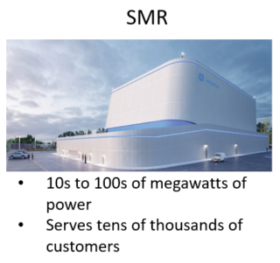Nuclear Microreactors are In Development
A Small Physical Footprint is a Selling Point
OK, local nuclear power might be the ultimate “not in my backyard” scenario, but it could have some merit in the future. Massive wind and solar farms are getting significant pushback from local communities in the U.S. and elsewhere, with land use a frequently cited part of the argument. A community in Florida recently got positive media coverage about how its 150 MW solar farm, covering 870 acres, helped it survive hurricane Ian. But how many communities have that much physical space to allocate to a power system?
Nuclear Microreactors
The common mental image of a nuclear reactor involves huge domed concrete structures and massive cooling towers emitting vapor. Small modular reactors (SMRs) are so new, I don’t think there’s a common mental image yet. For microreactors, picture a large shipping container.



For reference, units of power:
1 kW (kilowatt) = 1,000 watts
1 MW (megawatt) = 1 million watts = 1,000 kW
1 GW (gigawatt) = 1 billion watts = 1,000 MW
Microreactors aren’t a reality yet, but at least one design, the Westinghouse eVinci system, is currently being reviewed by the U.S. Nuclear Regulatory Commission and the Canadian Nuclear Safety Commission. Commercialization is years away. There are also other microreactor initiatives, such as Radiant Nuclear.
Westinghouse envisions applications like “electricity and heating for remote communities and islands, industrial sites, data centers, universities, defense facilities, marine propulsion, hydrogen generation and water purification.” [1] I don’t think it’s too much of a stretch to consider microgrid applications at the community level.
Microgrids
A national electrical grid encompasses hundreds or thousands of generating sources serving a massive and diverse set of loads. A microgrid is a local power generation source serving local loads, such as a small town, a part of a rural county, or a business.
Examples of microgrids already in operation:
- Wheatridge Renewable Energy Facility (Oregon) includes a 300 MW wind farm, a 50 MW solar facility and a 30 MW battery storage system. This system is capable of powering about 100,000 homes.[2]
- Babcock Ranch (Florida) with 680,000 solar panels and a battery system capable of supplying 1 MW of power for 4 hours.[3]
- Cordova, Alaska uses a 6 MW hydro powered microgrid with battery storage to produce power at $0.06/kWh [4]
Neighborhood Nuclear
Of course, safety and security concerns are significant issues with any nuclear power source. The lifecycle of the nuclear fuel is also a concern.
Both the Westinghouse and Radiant Nuclear microreactor designs utilize TRISO (TRi-structural ISOtropic) nuclear fuel pellets.
The pellets are made from tiny Uranium spheres coated with special carbon and ceramic layers. The layers prevent the release of radioactive fission products, making this fuel safer to transport and handle throughout its lifecycle in comparison to traditional nuclear fuel.
Because TRISO fuel pellets can withstand very high temperatures (3,000°F), they are highly resistant to meltdown at normal reactor operating temperatures (typically in a range of 1,200 to 2,000°F).
Physical footprint is a key aspect of any power generation source deployment. Nuclear microreactors are shipping container size, but deployment includes heat rejection equipment, electrical substation equipment and perhaps a small maintenance and monitoring structure. The deployment footprint for a 5 MW microreactor might be the size of about a third of a football field. Contrast that to 22 football fields for 5 MW of solar power generation or 3 football fields for 5 MW of wind power. The compact footprint of a microreactor is a significant selling point.
Another advantage of a nuclear microreactor: it supplies power continually, rain or shine, wind or no wind. A backup or alternate of electricity source would need to be available during annual maintenance of the microreactor. The likely annual availability of a microreactor is not known, but more than 90% would be expected.
The nuclear microreactor would not need to be in the immediate vicinity of a neighborhood. The 5 MW rating of the Westinghouse unit suggests a medium voltage output, which can be transmitted a reasonable distance economically. Locations for these units might be similar to those for current utility grid electrical substations.
Summary
Nuclear microreactors are one of many new technologies that may play a part in the energy source portfolio of the future. The commercialization of these products is a trend to watch, and may provide an emissions-free energy source for not only community microgrids, but other environmental applications such as water desalination plants and distributed carbon capture facilities.
It’s fun to dream about a clean energy world. To get there, I believe it will take many different technologies and actions by individuals, companies and governments. Individuals should be aware of the community-level actions that are feasible, and should support and advocate for those actions when possible. Community solar and wind are available today. Who knows what the future will bring?
[1] Westinghouse press release, September 27, 2022: https://info.westinghousenuclear.com/news/wec-advances-evinci-commercialization-canada
[2] Information about the Wheatridge microgrid: https://portlandgeneral.com/about/who-we-are/innovative-energy/wheatridge-renewable-energy-facility
[3] Information about the Babcock Ranch, Florida, microgrid: https://babcockranch.com/our-vision/core-initiatives/#energy
[4] The Cordova, Alaska, microgrid: https://www.cordovaelectric.com/cordova/cordovas-microgrid-integrates-battery-storage-with-hydropower/
Further reading on the topics in this article:
- Radiant Nuclear’s 1.2 MW microreactor: https://www.radiantnuclear.com/
- More about microgrids: https://www.powermag.com/why-microgrids-are-the-key-to-our-carbon-neutral-future/?itm_source=parsely-api
- TRISO Particles: The Most Robust Nuclear Fuel on Earth, U.S. Office of Nuclear Energy: https://www.energy.gov/ne/articles/triso-particles-most-robust-nuclear-fuel-earth
- Ultra Safe Nuclear, manufacturer of TRISO fuel: https://www.usnc.com/fuel/
- Idaho National Labs FAQ on microreactors: https://inl.gov/trending-topic/microreactors/frequently-asked-questions-microreactors/
